Heinrich J.G., Aldinger F. (Eds.) Ceramic Materials and Components for Engines
Подождите немного. Документ загружается.

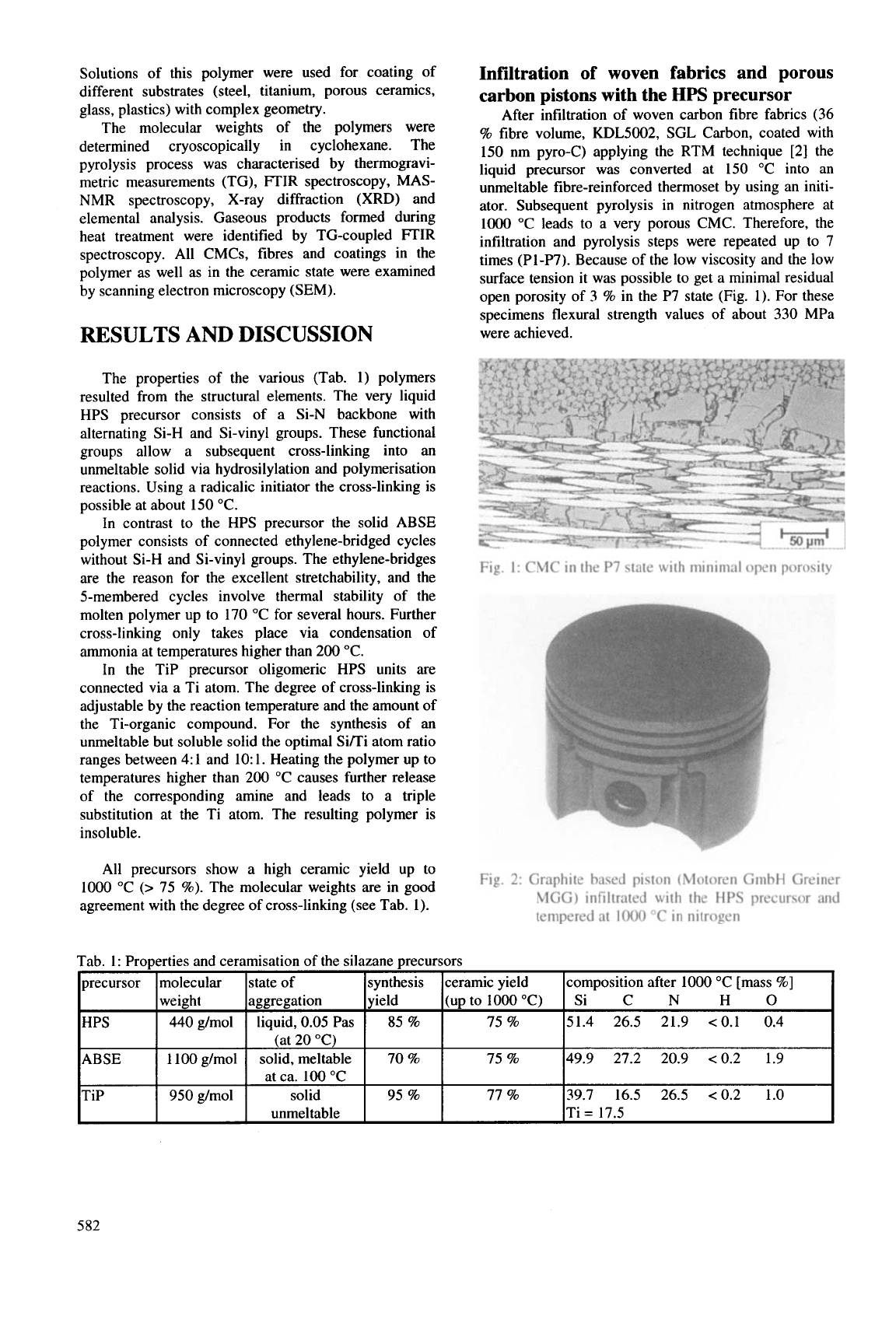
Solutions of this polymer were used for coating of
different substrates (steel, titanium, porous ceramics,
glass, plastics) with complex geometry.
The molecular weights of the polymers were
determined cryoscopically in cyclohexane. The
pyrolysis process was characterised by thermogravi-
metric measurements (TG), FTIR spectroscopy, MAS-
NMR spectroscopy, X-ray diffraction (XRD) and
elemental analysis. Gaseous products formed during
heat treatment were identified by TG-coupled FTIR
spectroscopy.
All
CMCs, fibres and coatings in the
polymer
as
well
as
in the ceramic state were examined
by scanning electron microscopy (SEM).
precursor molecular state of synthesis ceramic yield
HPS
440
g/mol liquid,
0.05
Pas
85
%
75
%
(at
20
"C)
ABSE
1100
g/mol solid, meltable 70
%
75
%
at ca.
100
"C
TiP 950 g/mol solid 95
%
77
%
unmeltable
weight aggregation yield (up to
1000
"C)
RESULTS AND DISCUSSION
composition after 1000 "C [mass
%]
Si C
N
HO
51.4
26.5 21.9
<
0.1
0.4
49.9 27.2 20.9
<
0.2 1.9
39.7
16.5
26.5
<
0.2
1.0
Ti
=
17.5
Infiltration of woven fabrics and porous
carbon pistons with the
HPS
precursor
After infiltration of woven carbon fibre fabrics (36
% fibre volume, KDL5002, SGL Carbon, coated with
150
nm pyro-C) applying the RTM technique [2] the
liquid precursor was converted at
150
"C into an
unmeltable fibre-reinforced thermoset by using an initi-
ator. Subsequent pyrolysis
in
nitrogen atmosphere at
lo00
"C leads to
a
very porous CMC. Therefore, the
infiltration and pyrolysis steps were repeated up to 7
times (PI-P7). Because of the low viscosity and the low
surface tension it was possible to get
a
minimal residual
open porosity of
3
%
in the P7 state (Fig. 1). For these
specimens flexural strength values of about 330 MPa
were achieved.
The properties of the various (Tab. 1) polymers
resulted from the structural elements. The very liquid
HPS precursor consists of
a
Si-N backbone with
alternating Si-H and Si-vinyl groups. These functional
groups allow
a
subsequent cross-linking into an
unmeltable solid via hydrosilylation and polymerisation
reactions. Using
a
radicalic initiator the cross-linking is
possible at about 150 "C.
In contrast to the HPS precursor the solid ABSE
polymer consists of connected ethylene-bridged cycles
without Si-H and Si-vinyl groups. The ethylene-bridges
are the reason
for
the excellent stretchability, and the
5-membered cycles involve thermal stability of the
molten polymer up to 170 "C for several hours. Further
cross-linking only takes place via condensation of
ammonia at temperatures higher than 200 "C.
In
the TiP precursor oligomeric HPS units are
connected via
a
Ti atom. The degree of cross-linking is
adjustable by the reaction temperature and the amount of
the Ti-organic compound. For the synthesis of an
unmeltable but soluble solid the optimal Si/Ti atom ratio
ranges between
4:
1 and 10:
1.
Heating the polymer up to
temperatures higher than 200 "C causes further release
of the corresponding amine and leads to
a triple
substitution at the Ti atom. The resulting polymer is
insoluble.
All
precursors show
a
high ceramic yield up to
1000 "C
(>
75
%).
The molecular weights are in good
agreement with the degree of cross-linking (see Tab.
I).
Fig.
1:
CMC in the P7 state with minimal open porosity
Fig. 2: Graphite based piston (Motoren GmbH Greiner
MGG) infiltrated with the HPS precursor and
tempered at 1000 "C in nitrogen
5
82

Graphite based pistons (Fig.
2)
offer
a
great potential
to reduce fuel and oil consumption
as
well
as
the
exhaust fumes emission. However, commercially
available graphite shows an open porosity of about
10
%
and
a
still too low strength. By the use of the HPS
precursor it was possible to close the open porosity of
the piston and to increase the strength of the graphite by
10 percent. Nevertheless, further optimisation is
necessary.
Processing ceramic fibres by using the
ABSE
precursor
The brittle and meltable ABSE polymer fulfil the
most important requirements for the melt spinning
process (high melting point, thermal stability, and
stretchability, suitable viscosity in the molten state). The
precursor was continuously meltspun to green fibres
with
a
diameter of
20
-
30
pm (withdrawal speed 500
dmin)
in
a
pilot plant at the Fraunhofer ISC Wiirzburg.
The fibre surface is smooth and the fracture surfaces
show no pores
or
cracks.
The main problem is to cure the green fibre
in
a
very
short time before pyrolysis for making the fibres
infusible. For silazanes the ABSE polymer shows an
astonishing resistance against moisture. Therefore,
handling
in
air is possible for
a
short time. However, the
low reactivity is disadvantageous for the chemical
curing process. In contrast, irradiation with electron
beam leads
in
a
very short time to further cross-linking
of the polymer backbone. The cured unmeltable fibres
show an acceptable flexibility.
After curing the fibres were heated up to lo00
"C
for
I
h in nitrogen atmosphere. The surface remained
smooth and no pores
or
cracks could be observed. To
investigate the oxidation behaviour the ceramized fibres
were heated for
12
h in air at 1500
"C.
Figures
3
and
4
illustrate the oxidation resistance even at such high
temperatures, because of the formation of
a
pore-free,
passivise surface.
Fig.
3:
SiCN fibre (ABSE) after oxidation in air at
1500 "C for
12
h
Fig. 4: Pore- and crackfree oxide coating on the fibre
Processing
of
polymer and ceramic-like
layers by using the TiP Precursor
surface
The TiP precursor is
a
moisture-sensitive solid.
Thus, coating can only be carried out
in
a
protective
atmosphere. The polymer can easily be dissolved
in
solvents such
as
cyclohexane, octane, toluene and
xylene. The adhesion on various substrates, i.e., on
metals, Si-wafer, ceramics, glass and plastics, is very
strong. The thickness of the polymer coating depends on
the concentration of the solution and the coating
technique used. The layer thickness ranges from
0.5
(for
dip-coating) up to
5
pm (for spraying). The polymer
coatings on steel-sheets and silicon-wafer was pyrolysed
in
a
furnace at various temperatures up to 1000
"C
both
in air and nitrogen
or
recently by laser radiation. This
method enables the creation of ceramic layers even on
aluminium or plastics.
By annealing in air, the nitrogen
in
the layer will be
partly replaced by oxygen, thus the system changes to
SiTi0,C. Therefore, oxygen free SiTiCN
as
well
as
SiTi0,C coatings can be produced. The possibility of
handling
in
air is of significance for the ceramisation
process, because pyrolysis can be also carried out
in
air,
which leads to
a
considerable simplification of the
process (Fig.
5).
The chemical stability of the coating against water,
almost all organic solvents and acids is already given
after hardening in air, whereas the corrosion stability of
the coating in an alkaline environment strongly depends
on the heat treatment.
In
most cases, good resistance to
bases is reached after annealing at
300
"C.
The hardness of the layers also strongly depends
from the annealing temperature. To measure the
hardness values of
thin
coatings and not the substrate
hardness,
a
microhardness measurement with
a
nano-
indenter (max. load
5
mN)
was used. After cross-linking
at
130
"C the TIP layer shows
a
hardness value of about
0.43
GPa (universal hardness
[3]).
With rising annealing
temperature up to
1000
"C the hardness increases to
8.0
GPa. That is nearly the hardness of monolithic SiTiCN
ceramic
(8.5
GPa).
583
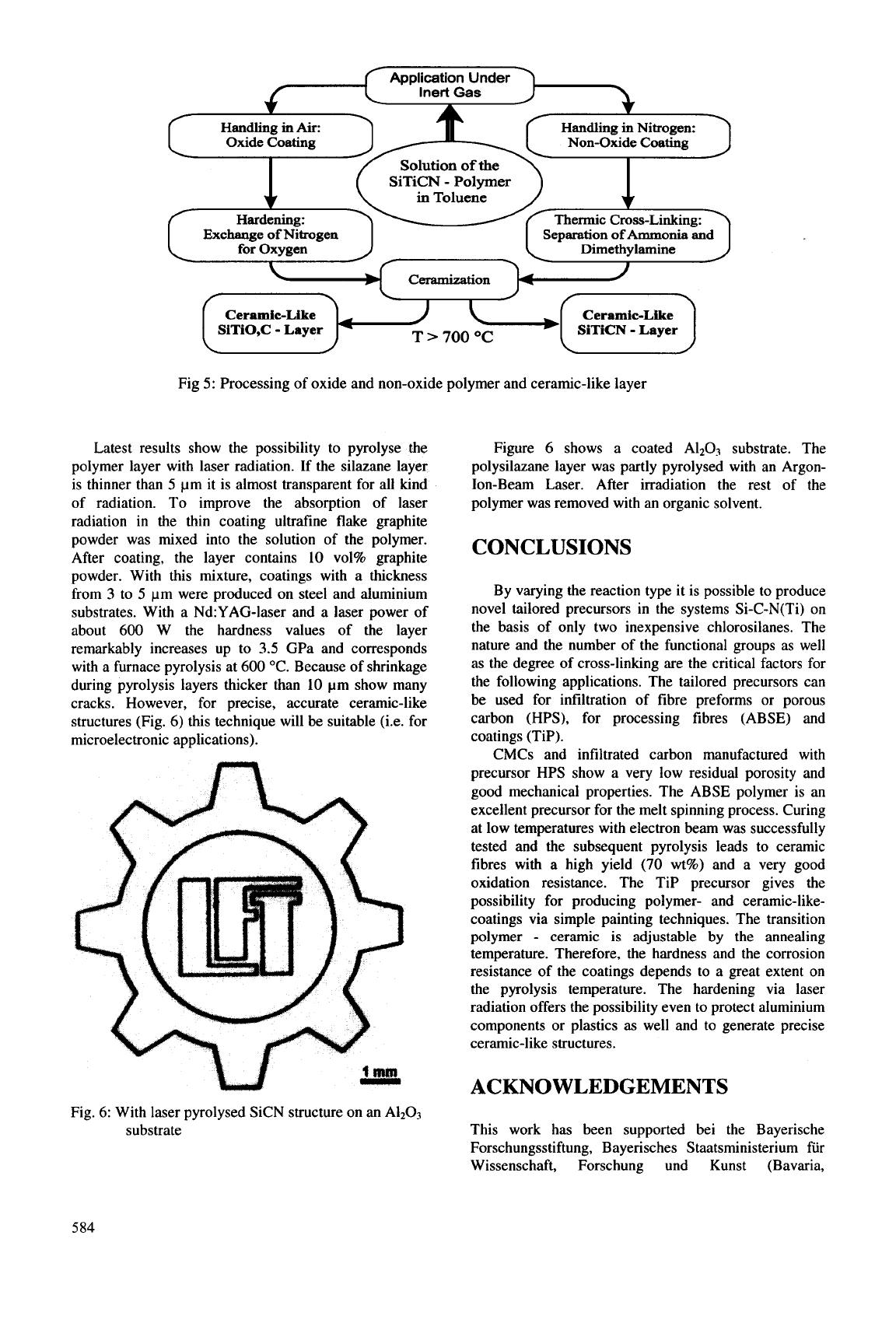
Handling
in
Nitrogen:
Non-Oxide
Coating
Separation
of
Ammonia and
ceramization
Handling
ink
Oxide Coating
Exchange
of
Nitrogen
Ceramic-Like Ceramic-Like
J
\
&[
SiTiCN
-
Layer
T
>
700
OC
SiTi0,C
-
Layer
I
Fig
5:
Processing of oxide and non-oxide polymer and ceramic-like layer
Latest results show the possibility to pyrolyse the
polymer layer with laser radiation. If the silazane layer
is thinner than
5
pm it is almost transparent for all kind
of radiation. To improve the absorption of laser
radiation in the thin coating ultrafine flake graphite
powder was mixed into the solution of the polymer.
After coating, the layer contains 10 vol% graphite
powder. With this mixture, coatings with
a
thickness
from
3
to
5
pm were produced on steel and aluminium
substrates. With
a Nd:YAG-laser and
a
laser power of
about
600
W the hardness values of the layer
remarkably increases up to
3.5
GPa and corresponds
with
a
furnace pyrolysis at
600
"C. Because of shrinkage
during pyrolysis layers thicker than
10
pm show many
cracks. However, for precise, accurate ceramic-like
structures (Fig.
6)
this technique will be suitable (i.e. for
microelectronic applications).
Fig.
6:
With laser pyrolysed SiCN structure on an A1203
substrate
Figure
6
shows a coated A1203 substrate. The
polysilazane layer was partly pyrolysed with an Argon-
Ion-Beam Laser. After irradiation the rest of the
polymer was removed with an organic solvent.
CONCLUSIONS
By varying the reaction type it is possible to produce
novel tailored precursors
in
the systems Si-C-N(Ti) on
the basis
of
only two inexpensive chlorosilanes. The
nature and the number of the functional groups
as
well
as
the degree of cross-linking are the critical factors for
the following applications. The tailored precursors can
be used for infiltration of fibre preforms
or
porous
carbon (HPS), for processing fibres (ABSE) and
coatings (TIP).
CMCs and infiltrated carbon manufactured with
precursor HPS show
a very low residual porosity and
good mechanical properties. The ABSE polymer is an
excellent precursor for the melt spinning process. Curing
at low temperatures with electron beam was successfully
tested and the subsequent pyrolysis leads to ceramic
fibres with
a high yield
(70
wt%) and a very good
oxidation resistance. The TiP precursor gives the
possibility for producing polymer- and ceramic-like-
coatings via simple painting techniques. The transition
polymer
-
ceramic is adjustable by the annealing
temperature. Therefore, the hardness and the corrosion
resistance
of
the coatings depends to a great extent on
the pyrolysis temperature. The hardening via laser
radiation offers the possibility even to protect aluminium
components
or
plastics
as
well and to generate precise
ceramic-like structures.
ACKNOWLEDGEMENTS
This work has been supported bei the Bayerische
Forschungsstiftung, Bayerisches Staatsministerium fur
Wissenschaft, Forschung und Kunst (Bavaria,
584
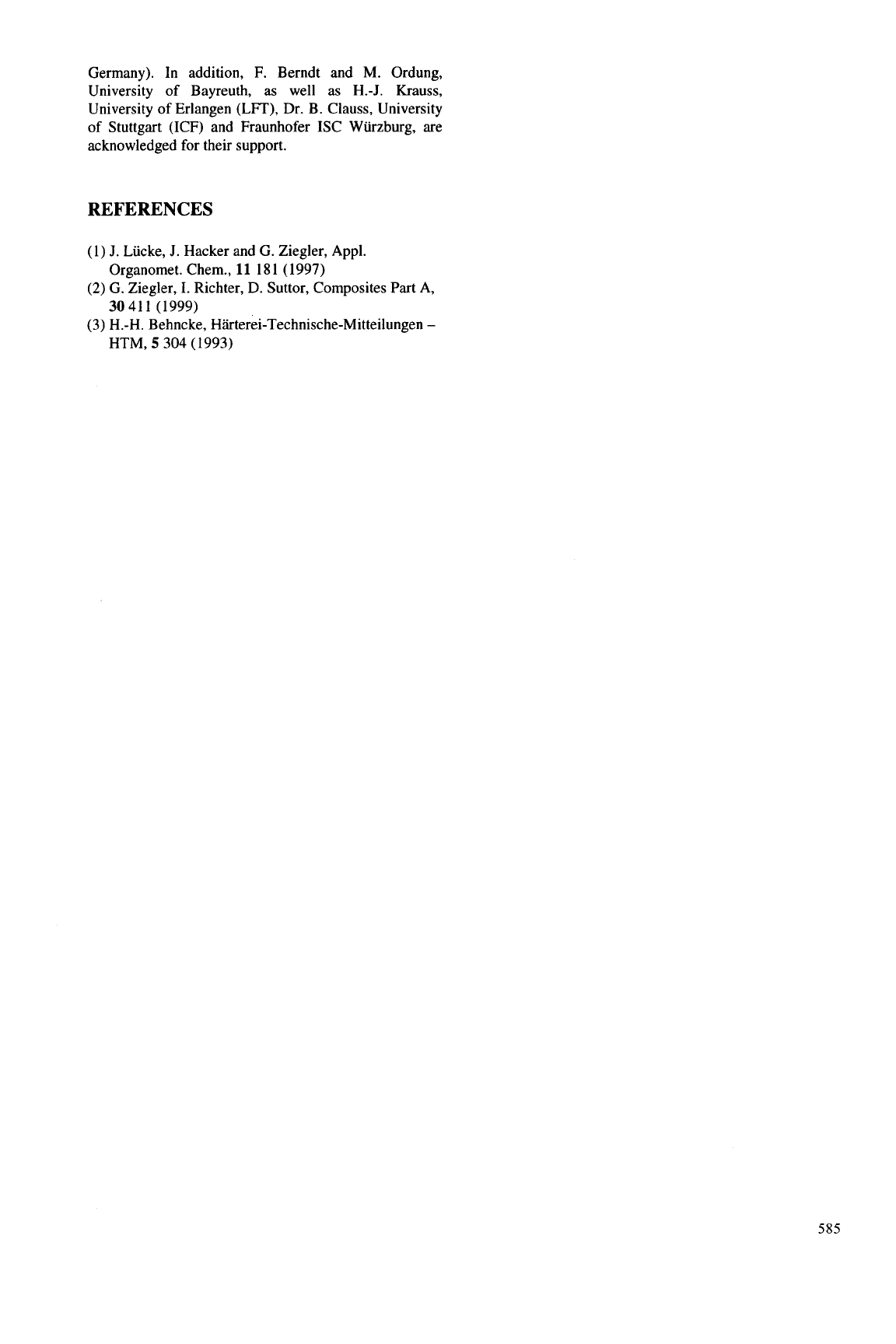
Germany). In addition, F. Berndt
and
M.
Ordung,
University of Bayreuth,
as
well
as
H.-J.
Krauss,
University of Erlangen
(LFT),
Dr. B. Clauss, University
of
Stuttgart (ICF) and Fraunhofer
ISC
Wurzburg, are
acknowledged for their support.
REFERENCES
(1)
J.
Lucke,
J.
Hacker and
G.
Ziegler, Appl.
(2)
G.
Ziegler,
I.
Richter, D. Suttor, Composites Part
A,
(3) H.-H. Behncke,
Hiirterei-Technische-Mitteilungen
-
Organomet.
Chern.,
11
181
(1997)
30
41
1
(1999)
HTM,
5
304 (1993)
585

This Page Intentionally Left Blank
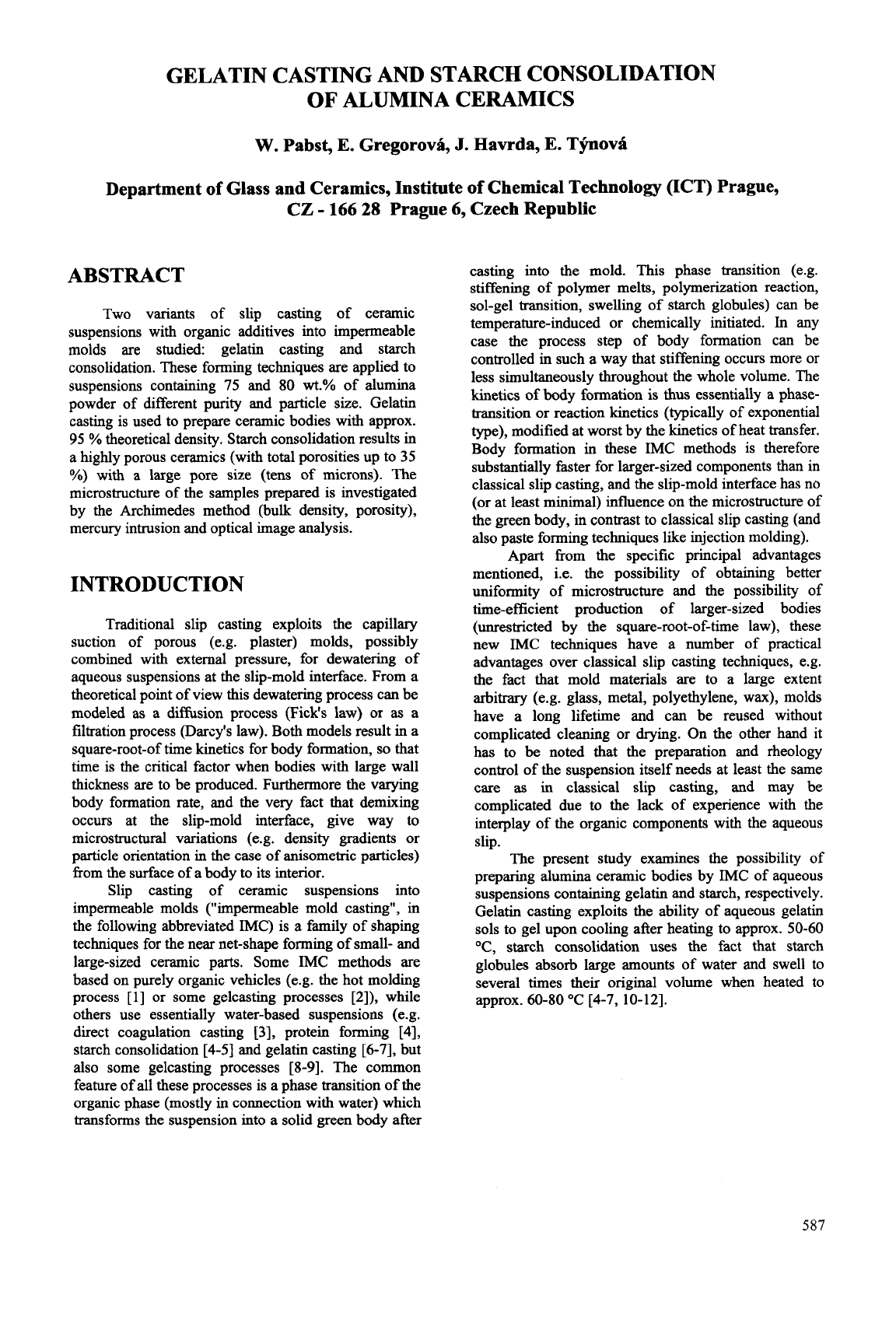
GELATIN CASTING AND STARCH CONSOLIDATION
OF
ALUMINA CERAMICS
W.
Pabst,
E.
Gregorovh,
J.
Havrda,
E.
Tfnovk
Department
of
Glass and Ceramics, Institute
of
Chemical Technology (ICT) Prague,
CZ
-
166
28
Prague
6,
Czech Republic
ABSTRACT
Two variants of slip casting of ceramic
suspensions with organic additives into impermeable
molds are studied: gelatin casting and starch
consolidation. These forming techniques are applied to
suspensions containing
75
and
80
wt.%
of alumina
powder of different purity and particle size. Gelatin
casting is used to prepare ceramic bodies with approx.
95
%
theoretical density. Starch consolidation results in
a highly porous ceramics (with total porosities up to
35
YO)
with a large pore size (tens of microns). The
microstructure of the samples prepared is investigated
by the Archimedes method (bulk density, porosity),
mercury intrusion and optical image analysis.
INTRODUCTION
Traditional slip casting exploits the capillary
suction of porous (e.g. plaster) molds, possibly
combined with external pressure, for dewatering of
aqueous suspensions at the slip-mold interface. From a
theoretical point of view this dewatering process can be
modeled
as
a diffusion process (Fick's law) or
as
a
filtration process (Darcy's law).
Both
models result in a
square-root-of time kinetics for body formation,
so
that
time is the critical factor when bodies with large wall
thickness are to be produced. Furthermore the varying
body formation rate, and the very fact that demixing
occurs at the slip-mold interface, give way to
microstructural variations (e.g. density gradients or
particle orientation in the case of anisometric particles)
from the surface of a body to its interior.
Slip casting of ceramic suspensions into
impermeable molds ("impermeable mold Casting", in
the following abbreviated
IMC)
is a family of shaping
techniques for the near net-shape forming of small- and
large-sized ceramic parts. Some IMC methods are
based on purely organic vehicles (e.g. the hot molding
process [l] or some gelcasting processes [2]), while
others use essentially water-based suspensions (e.g.
direct coagulation casting
[3],
protein forming
[4],
starch consolidation [4-51 and gelatin casting
[6-71,
but
also some gelcasting processes
[8-91.
The common
feature of all these processes is a phase transition of the
organic phase (mostly in connection with water) which
transforms the suspension into a solid green body after
casting into the mold. This phase transition (e.g.
stiffening of polymer melts, polymerization reaction,
sol-gel transition, swelling of starch globules) can be
temperature-induced or chemically initiated.
In
any
case the process step of body formation can be
controlled in such a way that stiffening occurs more or
less simultaneously throughout the whole volume. The
kinetics of body formation
is
thus essentially a phase-
transition or reaction kinetics (typically of exponential
type), modified at worst by the kinetics of heat transfer.
Body formation in these IMC methods is therefore
substantially faster for larger-sized components than in
classical slip casting, and the slip-mold interface has no
(or at least minimal) influence on the microstructure of
the green body, in contrast to classical slip casting (and
also paste forming techniques like injection molding).
Apart from
the
specific principal advantages
mentioned, i.e. the possibility of obtaining better
uniformity of microstructure and the possibility
of
time-efficient production of larger-sized bodies
(unrestricted by the square-root-of-time law), these
new
IMC
techniques have a number of practical
advantages over classical slip casting techniques, e.g.
the fact that mold materials are to a large extent
arbitrary (e.g. glass, metal, polyethylene, wax), molds
have a long lifetime and can be reused without
complicated cleaning or drying. On the other hand it
has to be noted that the preparation and rheology
control of the suspension itself needs at least the same
care
as
in classical slip casting, and may
be
complicated due to the lack of experience with the
interplay of the organic components with the aqueous
slip.
The present study examines the possibility of
preparing alumina ceramic bodies by
IMC
of aqueous
suspensions containing gelatin and starch, respectively.
Gelatin casting exploits the ability of aqueous gelatin
sols to gel upon cooling after heating to approx.
50-60
"C,
starch consolidation uses the fact that starch
globules absorb large amounts of water and swell to
several times their original volume when heated to
approx.
60-80
OC
[4-7,
10-121.
587
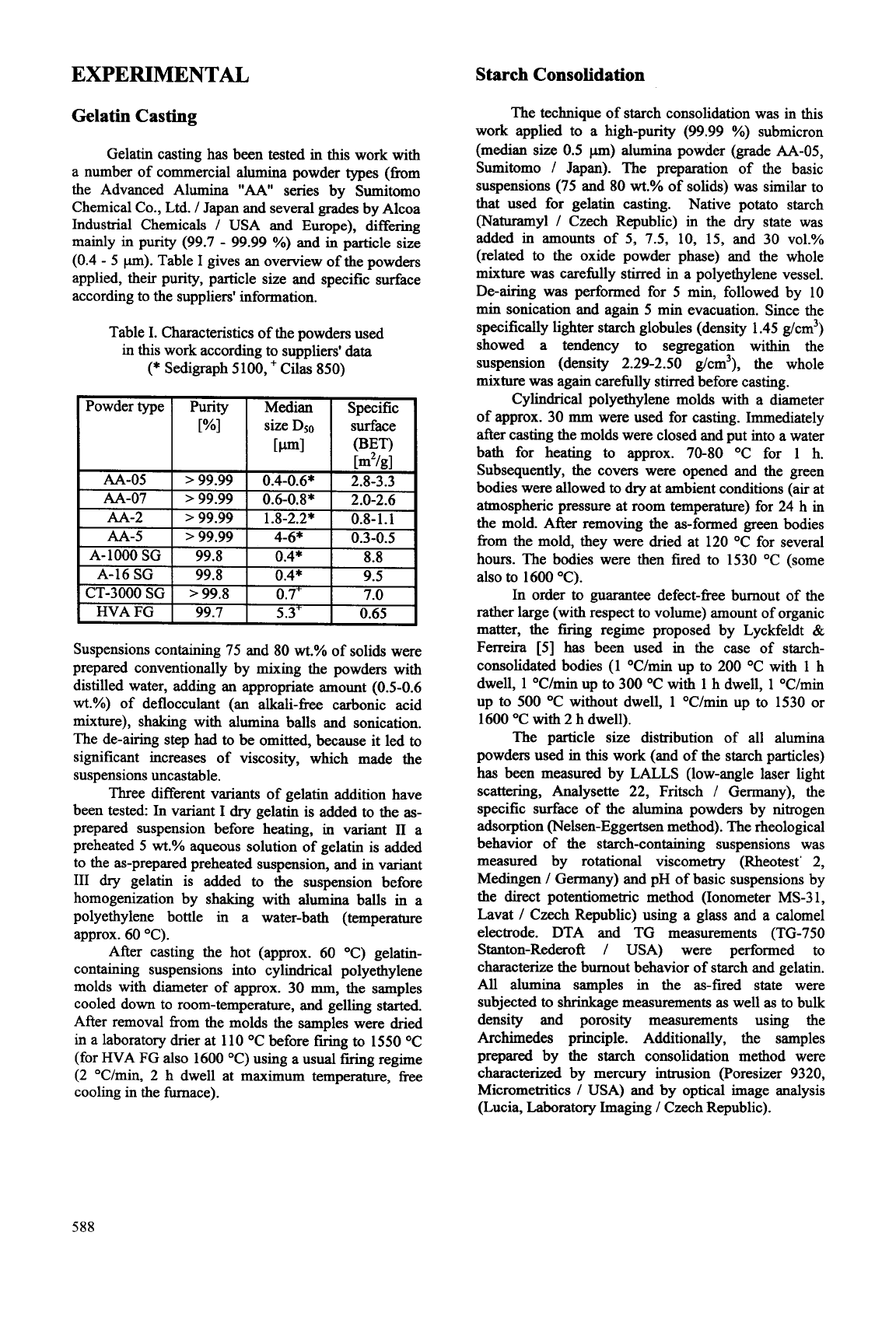
Starch Consolidation
Powdertype
Gelatin Casting
Purity
Median Specific
"1
sizeDSo surface
Gelatin casting has been tested in
this
work with
a number of commercial alumina powder types (hm
the Advanced Alumina
"AA"
series by Sumitomo
Chemical Co.,
Ltd.
/
Japan and several grades by Alcoa
Industrial Chemicals
/
USA and Europe), differing
mainly
in
purity (99.7
-
99.99
YO)
and
in
particle sue
(0.4
-
5
p).
Table I gives an overview of the powders
applied, their purity, particle size and specific surface
according to the suppliers' information.
AA-05
AA-07
Table I. Characteristics of the powders used
in this work according to suppliers' data
(*
Sedigraph 5100,
+
Cilas 850)
>
99.99
0.4-0.6* 2.8-3.3
>
99.99 0.6-0.8* 2.0-2.6
AA-2
AA-5
A-1000 SG
>
99.99
1.8-2.2* 0.8-1.1
>
99.99 4-6* 0.3-0.5
99.8 0.4* 8.8
A-16 SG 99.8
CT-3000 SG
>
99.8
HVA FG 99.7
~~
0.4* 9.5
0.7' 7.0
5.3' 0.65
Suspensions containing
75
and 80
wt.%
of solids were
prepared conventionally by mixing the powders with
distilled water, adding an appropriate amount (0.5-0.6
wt.%)
of
deflocculant (an alkali-& carbonic acid
mixture), shaking with alumina balls and sonication.
The de-airing step had
to
be omitted, because it led
to
significant increases of viscosity, which made the
suspensions uncastable.
Three different variants of gelatin addition have
been tested
In
variant I
dry
gelatin is added to the
as-
prepared suspension before heating, in variant I1 a
preheated 5
wt.%
aqueous solution of gelatin is added
to the as-prepared preheated suspension, and in variant
I11
dry
gelatin is added
to
the suspension before
homogenization by shaking with alumina balls in a
polyethylene bottle in a water-bath (temperature
approx. 60 "C).
After casting the hot (approx. 60 "C) gelatin-
containing suspensions into cylindrical polyethylene
molds with diameter of approx. 30
mm,
the samples
cooled down to room-temperature, and gelling started.
After removal from the molds the samples were dried
in
a
laboratory drier at 110 "C before firing to 1550 "C
(for HVA FG also 1600 "C) using a usual firing regime
(2
"C/min,
2
h
dwell at maximum temperature, free
cooling in the furnace).
The technique of starch consolidation was in this
work applied to a high-purity (99.99
YO)
submicron
(median size 0.5
pm)
alumina powder (grade AA-05,
Sumitomo
/
Japan). The preparation
of
the basic
suspensions (75 and 80
wt.%
of solids) was similar to
that used for gelatin casting. Native potato starch
(Naturamyl
/
Czech Republic) in the
dry
state was
added in amounts of
5,
7.5, 10,
15,
and 30 vol.%
(related
to
the oxide powder phase) and the whole
mixture was carehlly stirred in a polyethylene vessel.
De-airing was performed for 5 min, followed by 10
min sonication and again 5 min evacuation. Since the
specifically lighter starch globules (density 1.45 g/cm3)
showed a tendency
to
segregation within the
suspension (density 2.29-2.50 g/cm3), the whole
mixture was again carehlly stirred before casting.
Cylindrical polyethylene molds with a diameter
of approx. 30 mm were
used
for casting. Immediately
after casting the molds were closed and put into a water
bath for heating to approx. 70-80 OC for 1
h.
Subsequently, the covers were opened and the green
bodies were allowed to
dry
at ambient conditions (air at
atmospheric pressure at room temperature) for 24 h in
the mold. After removing the as-formed green bodies
flom the mold, they were dried at 120 "C for several
hours. The bodies were then fired to 1530 "C (some
also
to
1600 "C).
In order to guarantee defect-flee burnout of the
rather large (with respect to volume) amount of organic
matter, the firing regime proposed by Lyckfeldt
&
Ferreira [5] has been used in the case of starch-
consolidated bodies (1 "C/min up to 200 "C with 1 h
dwell, 1 "C/min up to 300 "C with 1 h dwell, 1 "C/min
up
to
500 "C without dwell, 1 OC/min up to 1530 or
1600 "C with 2 h dwell).
The particle size distribution of all alumina
powders used in
this
work (and of the starch particles)
has
been measured by LALLS (low-angle laser light
scattering, Analysette
22,
Fritsch
/
Germany), the
specific surface of the alumina powders by nitrogen
adsorption (Nelsen-Eggertsen method). The rheological
behavior of the starch-containing suspensions was
measured by rotational viscometry (Rheotest'
2,
Medingen
/
Germany) and pH of basic suspensions by
the direct potentiometric method (Ionometer MS-3
1,
Lavat
/
Czech Republic) using a glass and a calomel
electrode. DTA and TG measurements (TG-750
Stanton-Rederofi
/
USA) were performed
to
characterize the burnout behavior of starch and gelatin.
All alumina samples in the as-fired state were
subjected
to
shrinkage measurements
as
well
as
to bulk
density and porosity measurements using the
Archimedes principle. Additionally, the samples
prepared by the
starch consolidation method were
characterized by mercury intrusion (Poresizer 9320,
Micrometritics
I
USA) and by optical image analysis
(Lucia, Laboratory Imaging
/
Czech Republic).
588
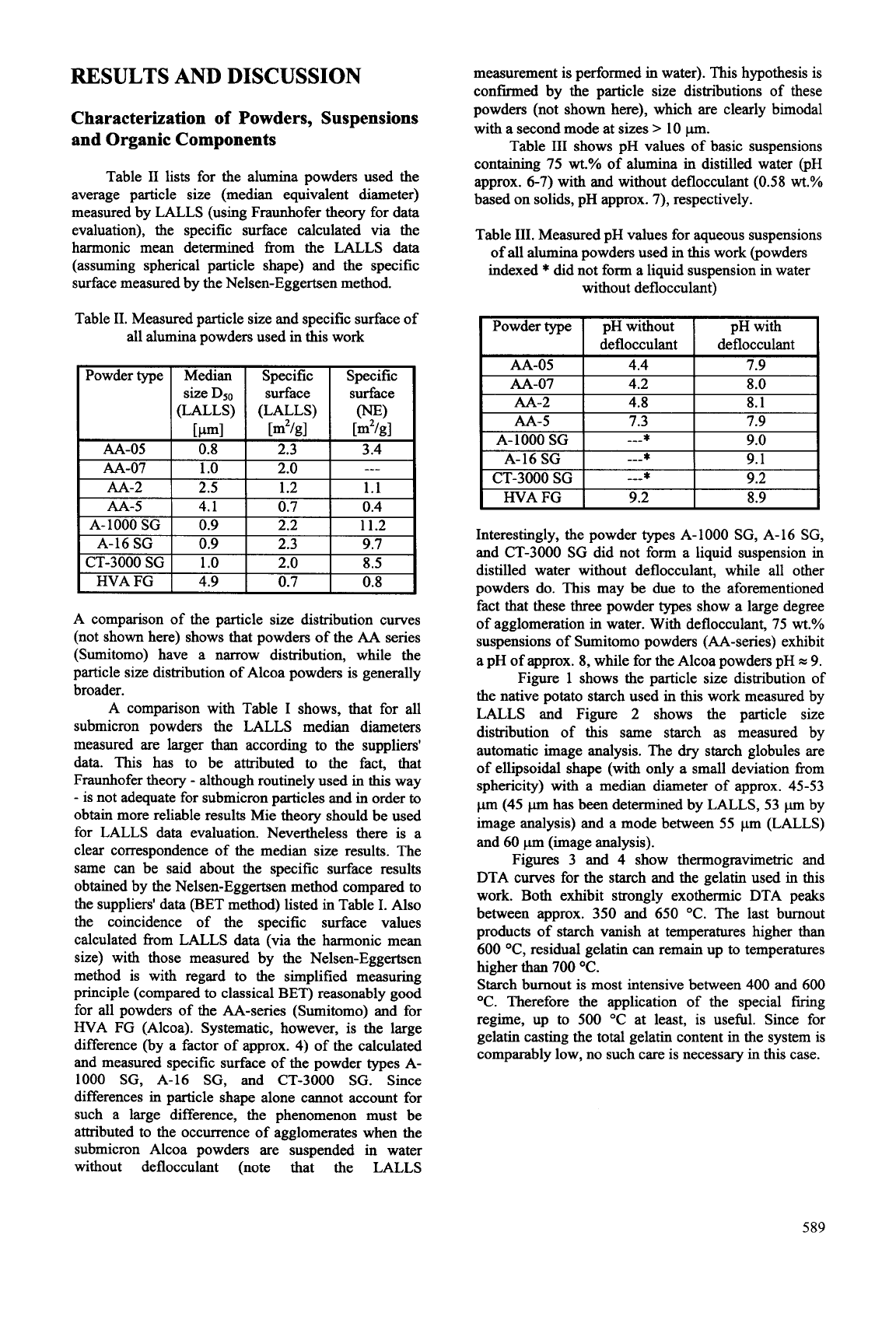
RESULTS
AND DISCUSSION
Powder type
AA-05
Characterization
of
Powders, Suspensions
and Organic Components
pH without pH with
de flocculant deflocculant
4.4 7.9
Table
I1
lists for the alumina powders used the
average particle size (median equivalent diameter)
measured by LALLS (using Fraunhofer theory for data
evaluation), the specific surface calculated via the
harmonic mean determined fiom the LALLS
data
(assuming spherical particle shape) and the specific
surface measured by the Nelsen-Eggertsen method.
I
Powdertype
I
Median-1
Sppctz
size DSo
Table
11.
Measured particle size and specific surface of
all alumina powders used in
this
work
Specific
surface
AA-07
AA-2
AA-5
4.2 8.0
4.8 8.1
7.3 7.9
A comparison of the particle size distribution curves
(not shown here) shows that powders of the AA series
(Sumitomo) have a narrow distribution, while the
particle size distribution of Alcoa powders is generally
broader.
A comparison with Table
I
shows, that for all
submicron powders the LALLS median diameters
measured are larger than according
to
the suppliers'
data. This has to be attributed
to
the fact, that
Fraunhofer theory
-
although routinely used in
this
way
-
is not adequate for submicron particles and in order
to
obtain more reliable results Mie theory should be used
for LALLS
data
evaluation. Nevertheless there is a
clear correspondence of the median size results. The
same can be said about the specific surface results
obtained by the Nelsen-Eggertsen method compared to
the suppliers' data (BET method) listed in Table
I.
Also
the coincidence of the specific surface values
calculated fiom LALLS
data
(via the harmonic mean
size) with those measured by the Nelsen-Eggertsen
method is with regard to the simplified measuring
principle (compared to classical
BET)
reasonably good
for all powders of the AA-series (Sumitomo) and for
HVA FG (Alcoa). Systematic, however, is the large
difference (by a factor of approx.
4)
of the calculated
and measured specific surface of the powder types A-
1000
SG,
A-16
SG, and CT-3000
SG.
Since
differences in particle shape alone cannot account for
such a large difference, the phenomenon must be
attributed to the occurrence of agglomerates when the
submicron Alcoa powders are suspended in water
without deflocculant (note that the LALLS
AA-05
measurement is performed in water). This hypothesis is
confirmed by the particle size distributions
of
these
powders (not shown here), which are clearly bimodal
with a second mode at sizes
>
10
pm.
Table
I11
shows pH values of basic suspensions
containing
75
wt.%
of alumina in distilled water (pH
approx.
6-7)
with and without deflocculant (0.58
wt.%
based on solids, pH approx.
7),
respectively.
(LALLS) (LALLS)
(NE)
[pml
b2kl
[m2k1
0.8 2.3 3.4
Table
111.
Measured pH values for aqueous suspensions
of all alumina powders used in
this
work (powders
indexed
*
did not form a liquid suspension in water
without deflocculant)
I
A-
1000
SG
---*
9.0
A-16 SG
---*
9.1
CT-3000
SG
---*
9.2
Interestingly, the powder types A- 1000 SG, A-
16
SG,
and
CT-3000
SG did not form a liquid suspension in
distilled water without deflocculant, while all other
powders do. This may be due to the aforementioned
fact that these three powder types show a large degree
of agglomeration in water. With deflocculant,
75
wt.%
suspensions of Sumitomo powders (AA-series) exhibit
a pH of approx. 8, while for the Alcoa powders pH
ir
9.
Figure
1
shows the particle size distribution of
the native potato starch used in this work measured by
LALLS and Figure 2 shows the particle size
distribution of
this
same starch as measured by
automatic image analysis. The
dry
starch globules are
of ellipsoidal shape (with only a small deviation fiom
sphericity) with a median diameter of approx.
45-53
pm
(45
pm
has been determined by LALLS,
53
pm by
image analysis) and a mode between
55
pm (LALLS)
and 60
pm
(image analysis).
Figures
3
and 4 show thermogravimetric and
DTA curves for the starch and the gelatin used in this
work. Both exhibit strongly exothermic DTA peaks
between approx.
350
and 650
OC.
The last burnout
products of starch vanish at temperatures higher than
600
OC, residual gelatin can remain up to temperatures
higher than
700
OC.
Starch burnout is most intensive between 400 and
600
"C.
Therefore the application of the special firing
regime, up to 500
"C
at least, is useful. Since for
gelatin casting the total gelatin content in the system is
comparably low, no such care is necessary in this case.
589
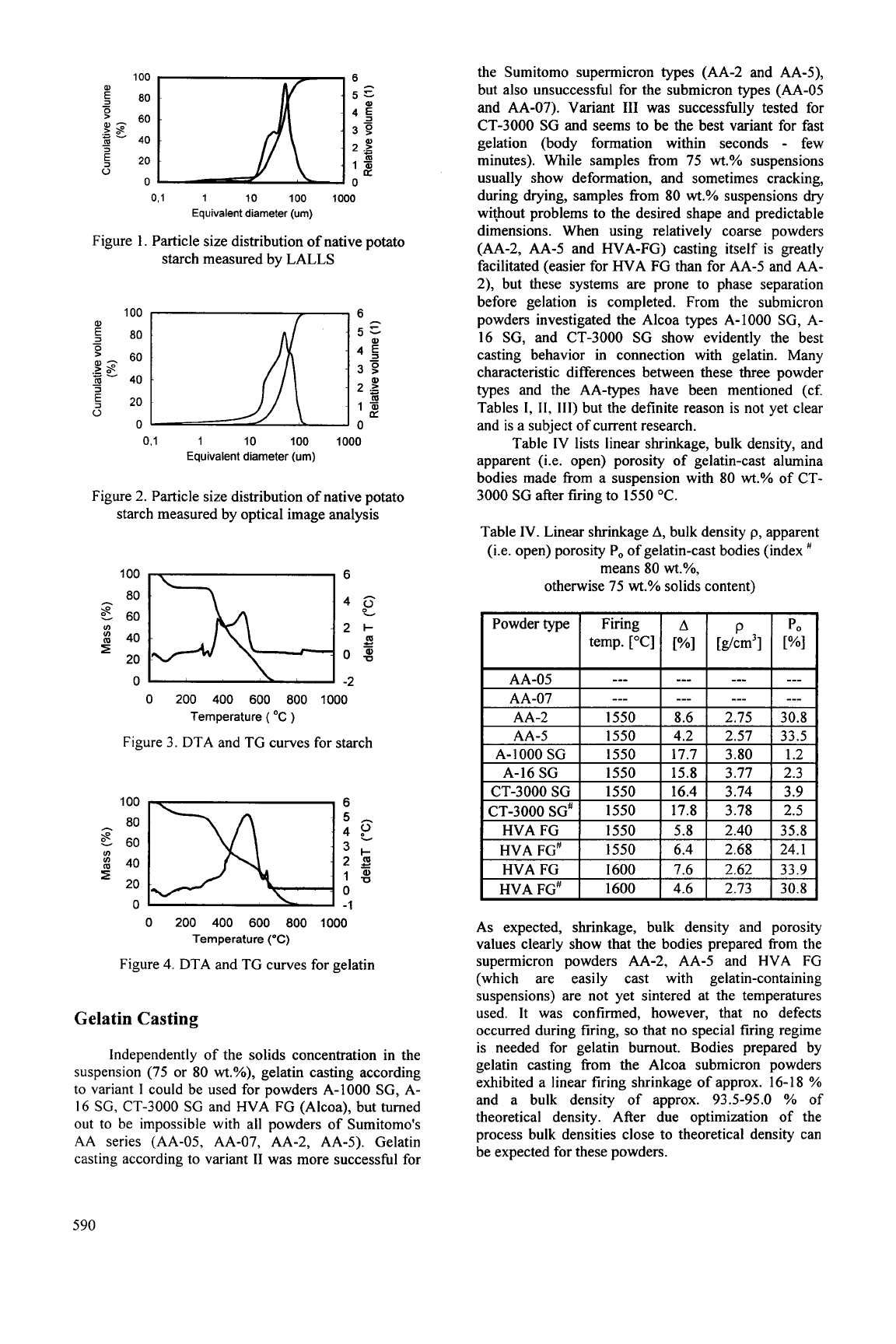
0.1
1
10
100
1000
Equivalent diameter (um)
Figure 1. Particle size distribution of native potato
starch measured by LALLS
Powdertype
0.1
1
10
100
1000
Equivalent diameter (um)
Firing
A
P
PO
temp.["C] ["/.I
[g/cm3] ["/.I
Figure
2.
Particle size distribution of native potato
starch measured by optical image analysis
l6
-2
0
200
400
600
800
1000
Temperature
(
OC
)
Figure
3.
DTA and TG curves for starch
6
5
42
ln
3,
ln
40
23
1%
0
0
-1
20
0
200
400
600
800 1000
Temperature
('C)
Figure
4.
DTA and TG curves for gelatin
Gelatin Casting
Independently of the solids concentration in the
suspension (75 or 80
wt.%),
gelatin casting according
to
variant
I
could be used for powders A-1000 SG,
A-
16
SG,
CT-3000 SG and HVA FG (Alcoa), but turned
out to be impossible with all powders of Sumitomo's
AA
series (AA-05, AA-07, AA-2, AA-5). Gelatin
casting according to variant
I1
was more successful for
the Sumitomo supermicron types (AA-2 and AA-5),
but also unsuccessful for the submicron types (AA-05
and AA-07). Variant
111
was successfully tested for
CT-3000 SG and seems to be the best variant for fast
gelation (body formation within seconds
-
few
minutes). While samples from 75
wt.%
suspensions
usually show deformation, and sometimes cracking,
during drying, samples from 80
wt.%
suspensions dry
without problems to the desired shape and predictable
dimensions. When using relatively coarse powders
(AA-2, AA-5 and HVA-FG) casting itself is greatly
facilitated (easier for HVA FG than for AA-5 and AA-
2), but these systems are prone to phase separation
before gelation is completed. From the submicron
powders investigated the Alcoa types A-1000
SG,
A-
16
SG,
and CT-3000 SG show evidently the best
casting behavior
in
connection with gelatin. Many
characteristic differences between these three powder
types and the AA-types have been mentioned (cf.
Tables
I,
11,
111)
but the definite reason is not yet clear
and is a subject of current research.
Table IV lists linear shrinkage, bulk density, and
apparent (i.e. open) porosity of gelatin-cast alumina
bodies made from a suspension with 80
wt.%
of CT-
3000 SG after firing to 1550 "C.
Table
IV.
Linear shrinkage
A,
bulk density
p,
apparent
(i.e. open) porosity Po of gelatin-cast bodies (index
'
means 80
wt.%,
otherwise 75
wt.%
solids content)
As expected, shrinkage, bulk density and porosity
values clearly show that the bodies prepared from the
supermicron powders AA-2, AA-5 and HVA FG
(which are easily cast with gelatin-containing
suspensions) are not yet sintered at the temperatures
used. It was confirmed, however, that no defects
occurred during firing,
so
that no special firing regime
is needed for gelatin burnout. Bodies prepared by
gelatin casting from the Alcoa submicron powders
exhibited a linear firing shrinkage of approx. 16-18
%
and a bulk density of approx. 93.5-95.0
'YO
of
theoretical density. After due optimization of the
process bulk densities close to theoretical density can
be expected for these powders.
590

Starch
Consolidation
Starch 7.5 vol.%
Median
[p]
53.2
55.8
Moderwnl 60
70
Table
V
lists shrinkage
A,
bulk density
p,
open
and total porosity (Po and P,) for as-fired alumina
bodies prepared by starch consolidation with 5,7.5, 10,
15 and 30 vol.% of
dry
starch (based on solids) in a
suspension containing 75
wt.%
and
80
wt.% of
AA-05
(after firing to 1530 OC and 1600
OC,
respectively).
15 vol.%
63.4
90
Table
V.
Linear shrinkage
A,
bulk density
p,
apparent
(i.e. open) porosity Po and total porosity Pt of starch-
consolidated bodies (index
'
means 80
wt.%,
otherwise
75
wt.%
solids content)
Starch content
7.5
15
[vol.o/,]
[vol.%]
[OC] cm31
1530 15.7 3.48 1.4 13.0
p
Po"] PtWI
wm31
3.02
15.7 26.3f 6.7
2.75
24.8 45.2f 5.9
It is evident that, when firing is performed under
atmospheric pressure, starch-consolidated bodies
cannot be densely sintered (i.e.
to
densities
approaching theoretical density
TD).
Lyckfeldt [4]
used 2-5 vol.% of starch in Si3N4 suspensions and
obtained 89.1
%
of
TD
for starch-consolidated Si3N4
bodies sintered by gas pressure sintering and 99.7
%
of
TD
by hot isostatic pressing. For starch contents
as
high
as
ours, starch acts at the same time
as
a
consolidating medium and
as
a pore-forming agent.
Porosities as high as 35
%
have been obtained and it
seems that even higher porosities might be realizable.
Table
VI
lists the bulk density p and open
porosity Po measured by mercury porosimetry and the
total porosity Pt determined by optical image analysis
on polished sections
of
fired (1530
"C)
alumina bodies
prepared fkom 75
wt.%
AA-05 suspensions with
7.5
and 15 vol.%
of
starch, respectively.
Table
VI.
Bulk density p and open porosity
Po
(as
measured by mercury porosimetry) and total porosity P,
(as measured by image analysis) of starch-consolidated
bodies
The bulk density and the open porosity determined by
mercury intrusion are in good agreement with the
values measured by the Archimedes principle (cf.
Table
V).
The total porosity measured by image
analysis contains a rather large error (absolute error in
porosity approx.
k
6 YO, which corresponds to a relative
error of 13-23
%),
but even within this error the
agreement is unsatisfactory for
the
highly porous
sample. The discrepancy is due to the insufficient
quality of the polished section (the preparation of
which is difficult in practice for such highly porous
samples).
Table
VII
lists some of the pore size
characteristics determined by image analysis for starch
and specimens of fired (1530
"C)
alumina bodies
prepared from 75
wt.%
AA-05
suspensions with 7.5
and 15 vol.% of starch, respectively.
Table
VII.
Pore size characteristics determined by
image analysis for starch and specimens of fired
(1
530
"C) alumina bodies prepared fkom 75
wt.%
AA-05
suspensions with 7.5 and 15 vol.% of starch
The pore sizes after firing (where the submicron
alumina skeleton can be assumed to be sintered) are of
the same order of magnitude
as
the particle size of
dry
starch. The absolute values are larger, which is not
surprising, since the starch undergoes swelling during
the heating step in water.
The pore size distribution obtained by mercury
intrusion shows a completely different picture (see
Figs.
5
and
6).
According
to
this method, the dominant
part of the (volume-weighted) pore size distribution
should be
in
the submicron range. The results of image
analysis (which are rather close to that of
dry
starch, cf.
Figs. 1 and 2) clearly prove that this is far fkom reality.
The reason for
this
discrepancy is the very unrealistic
model of a system
of
cylindrical pores with constant
diameter, which forms the basis of the evaluation of the
mercury intrusion
data
by the Washburn equation.
Knowing the realistic pore size distribution from image
analysis it is justified
to
interpret the minimum in the
fkequency curve fkom mercury intrusion
as
the most
fkequent size of interconnections between pores. For
the starch-consolidated specimens (both with
7.5
and
with 15 vol.% of starch in the suspension) this size is
approx. 7.4
p,
i.e. approx. one order of magnitude
smaller than the pore size.
7,
031
1
10
100
1000
Equivalent diameter (urn)
Figure
5.
Pore size distribution of as-fired alumina
sample (prepared from a 75 wt.% suspension with 7.5
vol.% starch) according
to
mercury intrusion
591
